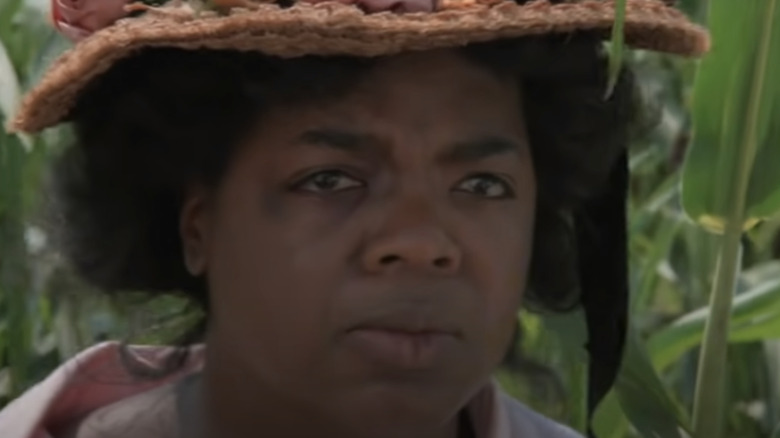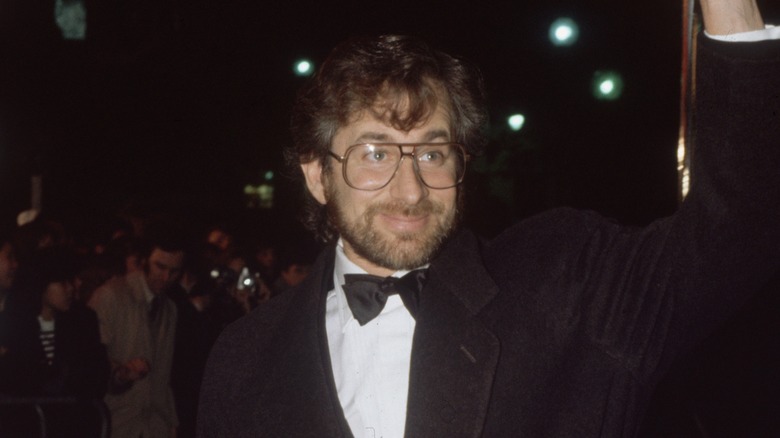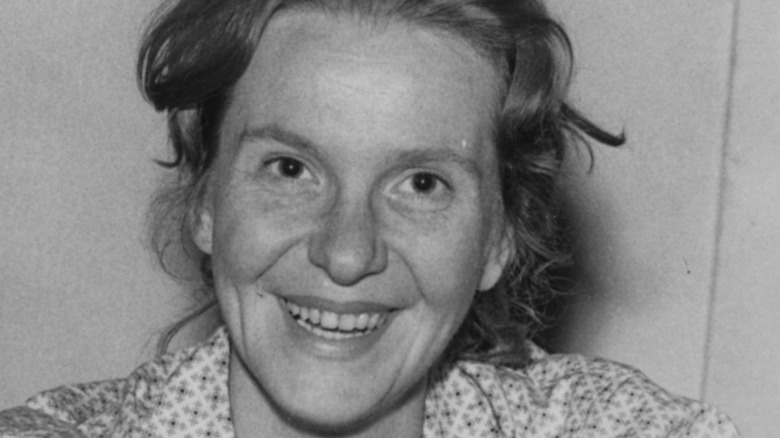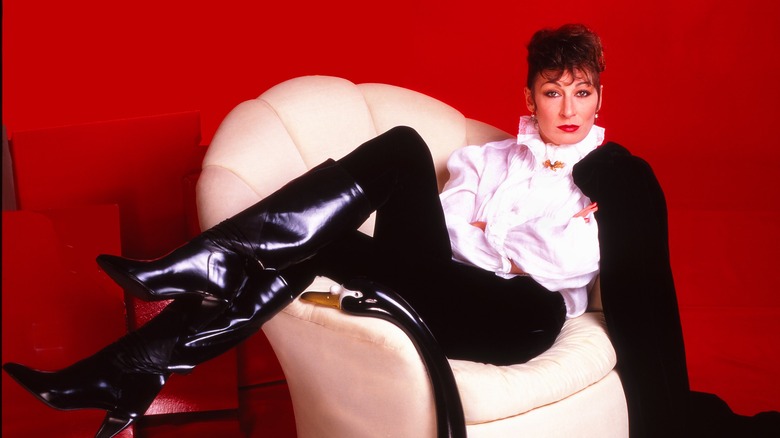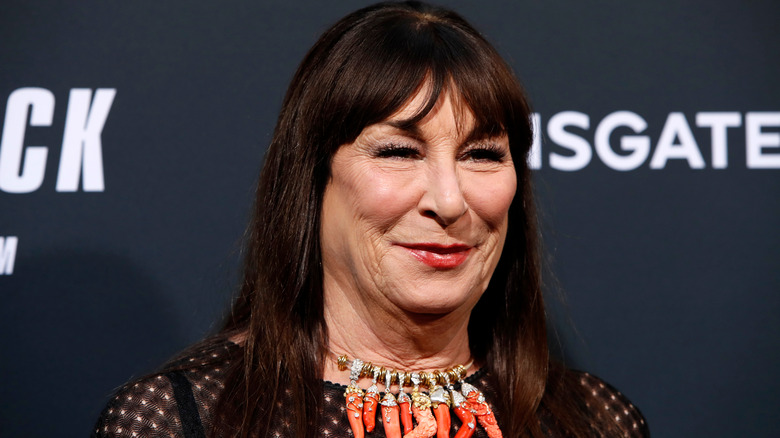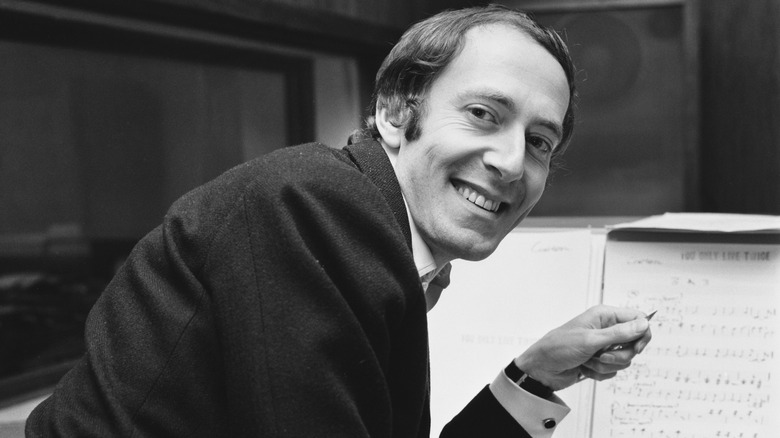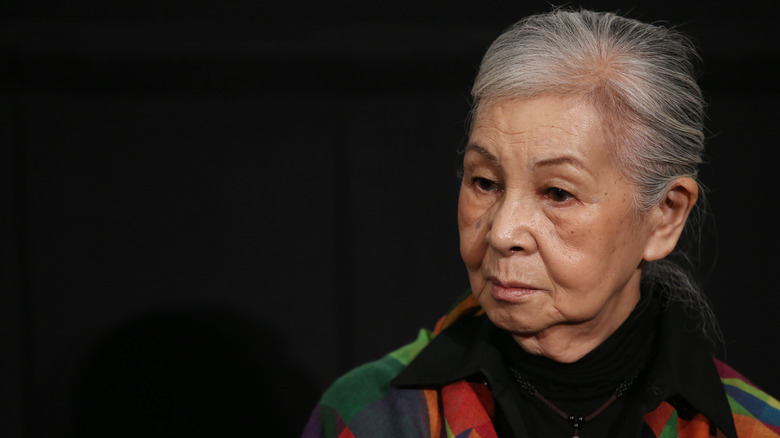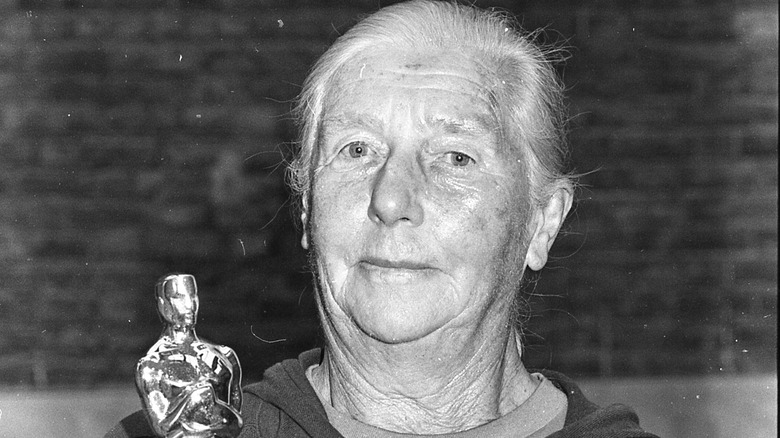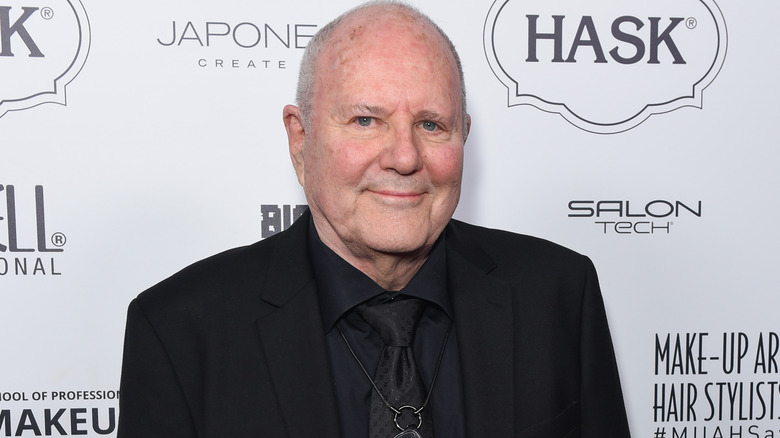The Color Purple Lost All 11 Of Its Oscars Nominations. Here's Who Won Them
Alice Walker's 1982 novel "The Color Purple" won the Pulitzer Prize for literature. As noted by The Nation, Walker was the first Black woman to win the award, and her victory sparked immediate controversy. Telling the story of a poor Black girl named Celie living in the American South in the early 20th century, the novel details horrific mental, physical, and sexual abuse, along with lesbian relationships and the struggles faced by poor Black people in America.
It's a complex and often disturbing novel with deep ties to the Black American experience. The book was guaranteed to be adapted into a film, but according to the American Film Institute, Walker was reluctant to sell the rights, concerned that Hollywood would not handle the material properly. When she finally agreed to sell the film rights, her contract required that she be a consultant on the production.
When Steven Spielberg was announced as the film's director, Oscar glory didn't seem assured. As noted by the Columbus Dispatch, Spielberg, while wildly successful, wasn't seen as a "serious" filmmaker. However, when the film was released, the reviews were rapturous: Chicago Sun-Times film critic Roger Ebert called it the best film of 1985, and it received a whopping 11 Oscar nominations. Then, shockingly, the film went on to lose all 11 — which is a record in itself, according to Guinness.
The 12th nomination
Almost as controversial as the 11 nominations "The Color Purple" did get was the one it didn't: Best Director. As reported by The Morning Call, Steven Spielberg was awarded Best Director by The Director's Guild of America, which made most people see him and his work in "The Color Purple" as a lock for nomination at the Academy Awards. But as noted by the Los Angeles Times, Spielberg didn't get that nomination, a fact many regarded as a "personal snub" to the director. According to The Washington Post, at the time many regarded Spielberg as the "man who ruined Hollywood" because of his approach to making crowd-pleasing, slick blockbusters.
Another reason speculated upon regarded the controversy surrounding the adaptation. As noted by "Black Oscars," Spielberg was criticized for removing much of the erotic detail concerning the story's central same-sex relationship and for flattening an exploration of generational abuse and violence into a more simplified story that struck some as a racist depiction of violent Black men. As noted by Allen Woll in the book "Twentieth-Century American Fiction on Screen," the backlash to the film from the Black community may have hurt its chances at the Oscars.
But when the film failed to win a single Oscar, the controversy shifted to the shutout. Jet Magazine reported that the National Association for the Advancement of Colored People (NAACP) accused the Academy of employing a tactic known as a "Black-out" to prevent Black-led projects from winning major awards.
Best Picture: Out of Africa
If you were taking bets on the film that would win Best Picture at the 58th Academy Awards in 1986, you might have given "The Color Purple" pretty good odds. The reviews were strong, with Janet Maslin of The New York Times saying the film has "momentum, warmth and staying power." According to The Washington Post, in the lead-up to the awards ceremony, the film was at the top of many critics' lists and was considered a favorite to win at least several Oscars.
When the award was announced, however, it was Sydney Pollack's "Out of Africa," starring Robert Redford and Meryl Streep, that took Best Picture. This was surprising on some levels because reviews for that film were much less glowing. The New York Times described it as "wispy" and criticized Redford's performance, calling his character a "cipher, and a charmless one at that." The Washington Post said the film has "little in the way of narrative drive" and complained that it "runs 2 1/2 hours and seems even longer."
As noted by USA Today, the performances in "The Color Purple" alone should have guaranteed the Best Picture Oscar, and The Washington Post openly wondered if anyone had ever bothered to sit down to watch "Out of Africa" a second time.
Actress in a Leading Role: Geraldine Page
Of the 11 Oscar losses "The Color Purple" suffered in 1986, one of the most surprising was when Whoopi Goldberg lost Best Actress. As noted by the British Film Institute, Goldberg's performance in the film is "remarkable" — and doubly so because it was her film debut as an actor. Goldberg was, as Yahoo! Entertainment notes, just a working comic in San Francisco at the time. Author Alice Walker happened to catch one of her comedy acts, and recommended that Steven Spielberg audition her for the role of Celie in the film.
As to why Goldberg didn't win despite her incredible performance, which did garner a Golden Globe in the same category, there are two main theories: One is the possibility that the outspoken Goldberg offended the academy voters. As noted by The Washington Post, Goldberg called the Academy "a small bunch of people with small minds," and the insult may have swayed votes away from her.
But some people believe the decision had more to do with the winner, Geraldine Page, who had been nominated seven times before but never won, per the Los Angeles Times. Page herself tacitly acknowledge this, saying that she hoped she'd won because she "did the best job" and not because of her many losses.
Actress in a Supporting Role: Anjelica Huston
Back in 1986, Oprah Winfrey wasn't yet the uber-successful icon that she is today. As noted by "African Americans and the Oscar," "The Color Purple" was Winfrey's debut film role, and she was so inexperienced that director Steven Spielberg had to remind her not to look directly into the camera while she auditioned.
In order to coax a performance from Winfrey, Spielberg played mind games, refusing to offer her praise and often not informing her of upsetting moments during a scene in order to get a raw, honest reaction from her. It paid off when Winfrey was nominated for an Academy Award for Best Actress in a Supporting Role. The Hollywood Reporter notes that Winfrey's Hollywood inexperience extended to the ceremony itself: She found herself praying she didn't win because her dress had been made too tight and she feared it would split open if she had to walk to the podium.
As it turned out, she didn't have to worry because Anjelica Huston won the Oscar for her performance in "Prizzi's Honor," a film directed by her father John Huston. According to Vanity Fair, Winfrey had been favored to win the award, and Huston claimed that the upset sparked a decades-long feud between the two women, noting that Oprah has never had her as a guest on her show and was often surprisingly rude to her when they found themselves at the same events.
Actress in a Supporting Role: Anjelica Huston ... Again
Margaret Avery has enjoyed a legendary career in Hollywood, with TCM reporting that she made her debut in the film "Something Evil" in 1972 working with a relatively unknown director (at the time) named Steven Spielberg. But she had to work to get the role of Shug in "The Color Purple." According to Essence, Avery was initially not considered for the role because the production team was looking for a singer. (In his book, "African Americans and the Oscar," author Edward Mapp notes that Tina Turner was initially offered the role.) But Avery used professional connections to get a taped reading to Spielberg, who then cast her.
Campaigning for the award, Avery stirred up controversy when she paid for an advertisement in the form of a letter written in a weirdly stereotypical dialect that began "Dear God, My name is Margaret Avery. I knows dat I been blessed by Alice Walker, Steven Spielberg, and Quincy Jones." According to People (via Business Insider), the ad cost Avery $1,160, and choosing to write in an "ebonics" style drew a storm of criticism that may have hurt Avery's chances. It may have hurt her career options as well, as Avery concedes she didn't work for two years after losing the Oscar to Anjelica Huston.
Writing (Screenplay Based on Material from Another Medium): Kurt Luedtke
As noted by Alive Walker herself in the book "The Same River Twice," adapting the Pulitzer Prize-winning novel "The Color Purple" presented a number of challenges as a screenwriter. The novel is structured as a series of letters, which doesn't lend itself to a striking visual feast for the eye. Steven Spielberg worked with several writers, and all of them told the director the novel couldn't be adapted. When Spielberg turned to screenwriter Menno Meyjes, the Dutch native believed otherwise: He thought the simplicity of the story would make it very easy to adapt. According to "Understanding Steven Spielberg," the director ultimately hired Meyjes because he believed he "understood the soul of the story."
The Academy agreed and, as reported by The New York Times, nominated Meyjes for adapted screenplay (officially Best Screenplay based on Material from Another Medium). But it was not meant to be — instead of Meyjes, The Washington Post notes it was Kurt Luedtke taking home the Oscar for his work adapting the novel "Out of Africa."
This was surprising because the reviews for "Out of Africa" weren't great. The Washington Post called it "numbingly paced and portentously orchestrated" and complained that Luedtke's script "never really gets inside Africa." The film's legacy hasn't improved: In 2009, film critic James Berardinelli said "it's almost impossible to guess how it won the Oscar for Best Picture" and called the story "lazy."
Cinematography: David Watkin
One of the least controversial losses that "The Color Purple" suffered at the 58th Annual Academy Awards came in the category of Best Cinematography. Although reviews for "Out of Africa" as a whole were underwhelming, most critics highlighted David Watkins' work behind the camera. The New York Times considered his work to be one of the few "peripheral" pleasures of the film, and critic James Berardinelli called the cinematography of the film "poetic." As noted by the Los Angeles Times, Watkin was considered an innovative cinematographer hired when directors wanted unique and striking visual styles in their films.
So Allen Daviau, nominated for his work on "The Color Purple," couldn't have been too surprised when he lost to Watkin. As noted by Variety, Daviau had been previously nominated for an Oscar for his work on 1982's "E.T. the Extra-Terrestrial" and would go on to be nominated three more times in his storied career (for "Empire of the Sun," "Avalon," and "Bugsy" — although he never actually won an Oscar. According to The Hollywood Reporter, Daviau and Steven Spielberg's collaboration on "The Color Purple" was no accident: Daviau worked on some of Spielberg's earliest films in the late 1960s. He came to be regarded as the consummate craftsman and earned lifetime achievement awards from the Art Directors Guild and the American Society of Cinematographers, underscoring how deserving he was of an Oscar.
Music (Original Song): Lionel Richie
Lionel Richie had better odds than most people to have a good night at the Oscars in 1986. According to Billboard, he was nominated for two songs in the Best Original Song Category, "Miss Celie's Blues (Sister)" from "The Color Purple — which "Hollywood Musicals Nominated for Best Picture" notes was co-written with Quincy Jones and Rod Temperton — and "Say You, Say Me" from the film "White Knights."
According to author Graham Betts in the book, "Motown Encyclopedia," "Say You, Say Me" was problematic for Richie because the film's soundtrack was to be released on Atlantic, not Motown. But Motown refused to let the song be included there and released it separately. The song quickly became a worldwide hit.
As per author Eileen M. Hayes in her book, "Songs in Black and Lavender," "Miss Celie's Blues (Sister)" has gone on to have a prominent legacy as a Black LGBTQ anthem as a song with clear lesbian themes. Its other legacy is less inspiring: As noted by Billboard, losing the Oscar for this song is one reason Quincy has not yet achieved EGOT (Emmy, Grammy, Oscar, Tony) status.
Music (Original Score): John Barry
Continuing a theme of "controversy" surrounding every single Academy Award "The Color Purple" was nominated for, the usually sedate category of "Best Original Score" was pretty tense in 1986. Producer Quincy Jones, which the official Oscars website notes had 11 co-composers, was nominated for his work on the film — but so was Georges Delerue, for "Agnes of God."
This was awkward because, as author Stephan Eicke notes in his book "The Struggle Behind the Soundtrack," Steven Spielberg had used an older Delerue composition as temporary music for the main titles of the film — and the piece of music Jones delivered to replace it sounded notably similar. So similar that many people prayed neither Jones nor Delerue won in order to avoid dealing with the situation. A sigh of relief came when John Barry won instead awarded for his work on "Out of Africa."
It's impossible to say whether this controversy killed any chance Jones had of scoring an Oscar for his work, but film music writer Jon Burlingame reports at The Film Music Society that the night before the Oscars, Delerue was offered a "huge settlement" over the similarities, and was later offered work —perhaps as a means of compensation — by Spielberg. It's safe to assume that everyone was at least aware of the accusations.
Costume Design: Emi Wada
When Aggie Guerard Rodgers lost the Best Costume Design Oscar to Emi Wada, who worked on the film "Ran" with director Akira Kurosawa, she may have been battling deep voting trends. As noted by the Los Angeles Times, there was at that time a sense that period films set outside the United States had an obvious edge when it came to awards time. And "Ran," which the encyclopedia Britannica notes was "an adaptation of Shakespeare's 'King Lear' set in 16th century Japan," sat comfortably inside that trend.
As TCM notes, Rodgers has enjoyed a career that stretches back to early 1973, when she designed the costumes for George Lucas' iconic "American Graffiti." According to film historian Robin Blaetz in the book "Costume, Makeup, and Hair," Lucas hired Rodgers because she had direct experience with the setting and time period of the film, worked with a minimal budget, and did her best to create "realistic" characters with her costumes as opposed to dramatic looks. In "FilmCraft: Costume Design," Rodgers notes this was her approach for "The Color Purple" as well, using old catalogs to capture authentic looks for the characters in the film. It was enough for her work to be recognized with an Oscar nod, but not enough to win.
Art Direction and Set Design: Stephen Grimes and Josie MacAvine
Art Director J. Michael Riva did incredible work on "The Color Purple." As noted by author Salamishah Tillet in the book "In Search of The Color Purple," the original intention was to film in Alice Walker's childhood home, but they discovered that the town had become too developed in the intervening decades. The production team instead selected a house in the middle of nowhere, allowing Riva to literally build the world of the film from scratch, even flying in dirt from Georgia to make everything look authentic.
Unfortunately for Riva, he was up against Stephen Grimes and "Out of Africa's" incredible location shooting in Kenya. As noted by the Oscars, Grimes made several trips to the area to sketch and plan the sets and other artistic designs for the film, and the results were spectacular. Meanwhile, the American Film Institute reports that set designer Josie MacAvin put considerable effort into locating the actual possessions of the original book's author Karen Blixen, who had sold almost everything before leaving Africa. The end result is a beautiful and authentic art and set design that critics like Kathleen Carroll at The Daily News called "vibrant" and "lush" in no small part because of the efforts of MacAvin and Grimes — who took home the Oscar in 1986.
Makeup: Michael Westmore and Zoltan Elek
Ken Chase, nominated for Best Makeup for his work on "The Color Purple," had his work cut out for him. As noted by the American Society of Cinematographers, Chase had to deal with the challenges of ensuring the darker skin tones of the Black actors involved in the production wouldn't get lost in the lighting and backgrounds. At the same time, Chase also had to contrive ways of aging the actors 30 years over the course of the film — all while maintaining a natural and authentic look. His success in all of these goals is why he was nominated.
The winners in the category, however, were just as deserving. The New York Post reports that makeup artist Michael Westmore comes from a long line of Hollywood makeup artists, and as noted by the Budapest Reporter Zoltan Elek has worked on nearly 100 films. Together the two men faced a real challenge when working on "Mask." According to KPCC News, to meet the challenge of replicating the look of a boy suffering from a rare bone-growth disease, he initially hoped the producers would cast an actor with wide-spaced eyes, but the eventual star, Eric Stoltz, did not — so a makeup solution had to be invented. Westmore states in his memoir "Makeup Man" that he had to remake the mask eight times, and each time a new problem would surface that required another revision. There really was no wrong choice in this category.
